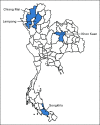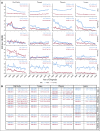Temporal Changes in Head and Neck Cancer Incidence in Thailand Suggest Changing Oropharyngeal Epidemiology in the Region
- PMID: 30860955
- PMCID: PMC6449079
- DOI: 10.1200/JGO.18.00219
Temporal Changes in Head and Neck Cancer Incidence in Thailand Suggest Changing Oropharyngeal Epidemiology in the Region
Abstract
Purpose: Head and neck cancer is the sixth most common cancer in the world, and the largest burden occurs in developing countries. Although the primary risk factors have been well characterized, little is known about temporal trends in head and neck cancer across Thailand.
Methods: Head and neck squamous cell carcinoma (HNSCC) occurrences diagnosed between 1990 and 2014 were selected by International Classification of Diseases (10th revision; ICD10) code from the Songkhla, Lampang, Chiang Mai, and Khon Kaen cancer registries and the US SEER program for oral cavity (ICD10 codes 00, 03-06), tongue (ICD10 codes 01-02), pharynx (ICD10 codes 09-10, 12-14), and larynx (ICD10 code 32). The data were analyzed using R and Joinpoint regression software to determine age-standardized incidence rates and trends of annual percent change (APC). Incidence rates were standardized using the Segi (1960) population. Stratified linear regression models were conducted to assess temporal trends in early-onset HNSCC across 20-year age groups.
Results: Although overall HNSCC rates are decreasing across all registries, subsite analyses demonstrate consistent decreases in both larynx and oral cavity cancers but suggest increases in tongue cancers among both sexes in the United States (APCmen, 2.36; APCwomen, 0.77) and in pharyngeal cancer in Khon Kaen and US men (APC, 2.1 and 2.23, respectively). Age-stratified APC analyses to assess young-onset (< 60 years old) trends demonstrated increased incidence in tongue cancer in Thailand and the United States as well as in pharyngeal cancers in Khon Kaen men age 40 to 59 years and US men age 50 to 59 years.
Conclusion: Although overall trends in HNSCC are decreasing across both Thailand and the United States, there is reason to believe that the etiologic shift to oropharyngeal cancers in the United States may be occurring in Thailand.
Conflict of interest statement
Katie R. Zarins
Laura S. Rozek
No other potential conflicts of interest were reported.
Figures


References
-
- Fitzmaurice C, Allen C, Barber RM, et al. Global, regional, and national cancer incidence, mortality, years of life lost, years lived with disability, and disability-adjusted life-years for 32 cancer groups, 1990 to 2015: A systematic analysis for the global burden of disease study. JAMA Oncol. 2017;3:524–548. - PMC - PubMed
-
- Jemal A, Bray F, Center MM, et al. Global cancer statistics. CA Cancer J Clin. 2011;61:69–90. - PubMed
-
- WHO . Head and Neck Cancer: Review of Cancer Medicines on the WHO List of Essential Medicines. 2014. Geneva, Switzerland, WHO.
-
- Parkin DM, Bray F, Ferlay J, et al. Global cancer statistics, 2002. CA Cancer J Clin. 2005;55:74–108. - PubMed
-
- Gupta B, Johnson NW, Kumar N. Global epidemiology of head and neck cancers: A continuing challenge. Oncology. 2016;91:13–23. - PubMed
MeSH terms
Grants and funding
LinkOut - more resources
Full Text Sources
Medical

